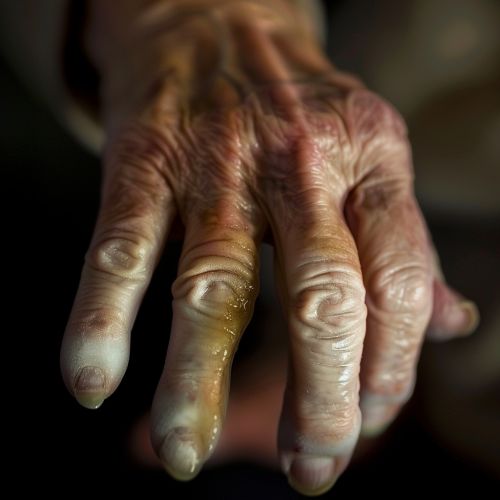Raynaud's Disease
Overview
Raynaud's disease is a medical condition that primarily affects the blood vessels in the fingers and toes. It is characterized by episodic attacks, known as 'Raynaud's phenomenon', where the blood vessels in the extremities constrict excessively in response to cold or emotional stress. This results in the affected areas turning white, then blue, and finally red upon rewarming – a sequence often referred to as the 'Raynaud's triphasic color response'.


Classification
Raynaud's disease is classified into two types: primary and secondary. Primary Raynaud's, also known as Raynaud's disease, is the most common form and occurs without an associated medical condition. Secondary Raynaud's, also known as Raynaud's phenomenon, is less common but more serious, as it is associated with an underlying disease or condition, often a connective tissue disorder such as rheumatoid arthritis or systemic lupus erythematosus.
Symptoms and Signs
The primary symptom of Raynaud's disease is a color change in the fingers or toes in response to cold or stress. The color change is often accompanied by a sensation of cold and numbness in the affected areas. As the attack subsides and blood flow returns, the fingers or toes may turn red and throb, tingle, or swell. The severity of the symptoms can vary from mild and infrequent to severe and chronic, affecting the quality of life of the individual.
Etiology
The exact cause of Raynaud's disease is unknown, but it is believed to involve an overreaction of the body's autonomic nervous system, which controls the narrowing and widening of the blood vessels. In people with Raynaud's disease, this system is hyperactive, causing an exaggerated response to cold or stress. Certain factors can increase the risk of developing Raynaud's disease, including gender (it is more common in women), age (it typically first appears before age 30), family history, and living in a cold climate.
Pathophysiology
The pathophysiology of Raynaud's disease involves an abnormal vasoconstrictive response to cold or stress. Under normal circumstances, the body responds to cold by constricting the peripheral blood vessels to conserve heat. In Raynaud's disease, this response is exaggerated, leading to an extreme constriction of the blood vessels (vasospasm) that reduces blood flow to the fingers and toes. This is followed by a compensatory dilation of the blood vessels as the body attempts to restore blood flow, leading to the characteristic color changes.
Diagnosis
Diagnosis of Raynaud's disease is primarily based on the patient's symptoms and medical history. The doctor may perform a physical examination and order certain tests, such as a nailfold capillaroscopy, to help rule out underlying diseases or conditions that could be causing the symptoms. In some cases, a process known as a 'cold stimulation test' may be used to trigger Raynaud's symptoms during the examination.
Treatment
Treatment for Raynaud's disease aims to reduce the frequency and severity of attacks and prevent tissue damage. This may involve lifestyle changes, such as avoiding cold temperatures, wearing warm gloves and socks, and managing stress. Medications may also be prescribed to help relax and widen the blood vessels, such as calcium channel blockers or vasodilators. In severe cases, surgical intervention may be considered.
Prognosis
The prognosis for individuals with Raynaud's disease varies depending on the type and severity of the condition. Those with primary Raynaud's generally have a good prognosis, as the condition is typically mild and manageable with lifestyle modifications. However, secondary Raynaud's can be more serious due to the underlying disease or condition, and may require more aggressive treatment.
Epidemiology
Raynaud's disease is relatively common, affecting up to 5% of the population in the United States. It is more prevalent in colder climates and in women, particularly those between the ages of 15 and 40. Primary Raynaud's is more common than secondary Raynaud's, accounting for about 80% of all cases.
